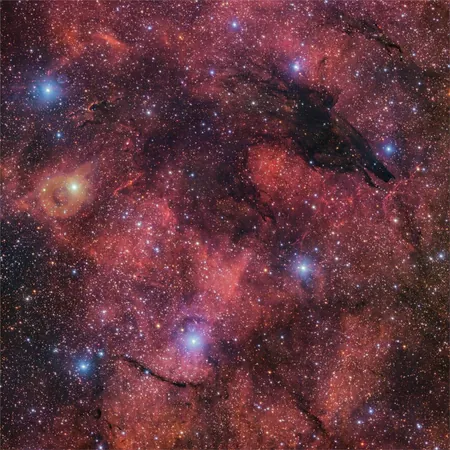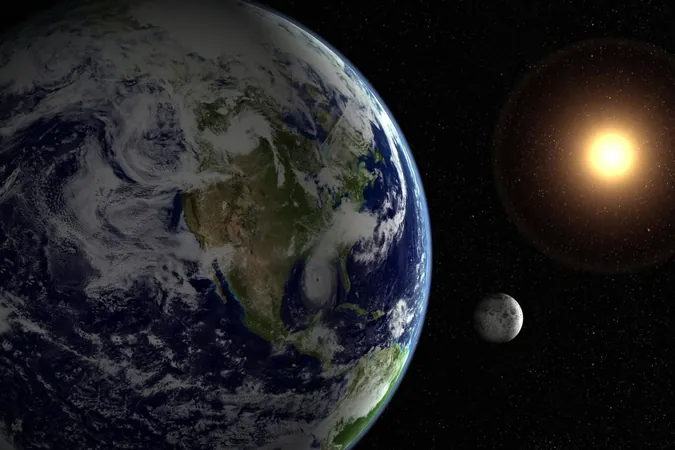
Unleashing the Dark Wolf Nebula: A Spooktacular Astronomical Discovery!
2024-11-01
Author: Nur
Introduction
In an exciting Halloween reveal, the European Southern Observatory (ESO) has unveiled an astonishing image of a dark nebula that intriguingly resembles a wolf against a stunning cosmic backdrop. Aptly named the Dark Wolf Nebula, this breathtaking 283-million-pixel image was captured using the VLT Survey Telescope (VST), based at the Paranal Observatory in Chile.
Location and Characteristics
Situated in the constellation Scorpius, near the heart of our Milky Way galaxy, this captivating nebula lies approximately 5,300 light-years away from Earth. What makes this image even more remarkable is that it covers an area of the sky equivalent to four full Moons, even though it forms a small section of a much larger nebula known as Gum 55. Look carefully, and you might even see the wolf take on a more menacing form, evoking the essence of a werewolf poised to pounce!
Nature of Dark Nebulae
Contrary to popular belief, darkness does not signify emptiness in the cosmos. Dark nebulae, like the Dark Wolf, are comprised of cold clouds of cosmic dust so thick that they block out the light from stars and other celestial objects behind them. Unlike their luminous counterparts, these dark nebulae do not emit visible light. Instead, the dust grains within them absorb visible wavelengths, allowing only longer wavelengths, such as infrared light, to pass through. This phenomenon makes them crucial for astronomers, as these chilled clouds often serve as the birthplace for new stars.
The Striking Image
The striking image showcases how the dark wolf stands out against the vivid star-forming clouds around it. These colorful formations primarily consist of hydrogen gas, glowing in shades of red that are energized by the intense ultraviolet radiation emitted by newly formed stars residing within.
For Comparison
While some dark nebulae like the Coalsack Nebula are visible to the naked eye and have significant cultural importance for many Indigenous peoples and their interpretations of the night sky, the Dark Wolf Nebula remains elusive. The image was crafted from data gathered by the VST, managed by Italy’s National Institute for Astrophysics (INAF) and hosted at ESO’s Paranal Observatory located in the Atacama Desert.
Surveys and Observations
Utilizing a specially designed camera, the VST captures the southern sky in visible light, compiling images taken through various color filters. These observations were part of the VST Photometric Hα Survey of the Southern Galactic Plane and Bulge (VPHAS+), encompassing studies of around 500 million objects within our galaxy. Such surveys are vital to astronomers as they unravel the complex life cycle of stars and the evolution of our universe.
Conclusion
So, why not dive into this cosmic treasure trove? Who knows what other mysterious figures and captivating phenomena await discovery in the depths of space? Explore the wonders of our universe today!



 Brasil (PT)
Brasil (PT)
 Canada (EN)
Canada (EN)
 Chile (ES)
Chile (ES)
 Česko (CS)
Česko (CS)
 대한민국 (KO)
대한민국 (KO)
 España (ES)
España (ES)
 France (FR)
France (FR)
 Hong Kong (EN)
Hong Kong (EN)
 Italia (IT)
Italia (IT)
 日本 (JA)
日本 (JA)
 Magyarország (HU)
Magyarország (HU)
 Norge (NO)
Norge (NO)
 Polska (PL)
Polska (PL)
 Schweiz (DE)
Schweiz (DE)
 Singapore (EN)
Singapore (EN)
 Sverige (SV)
Sverige (SV)
 Suomi (FI)
Suomi (FI)
 Türkiye (TR)
Türkiye (TR)
 الإمارات العربية المتحدة (AR)
الإمارات العربية المتحدة (AR)